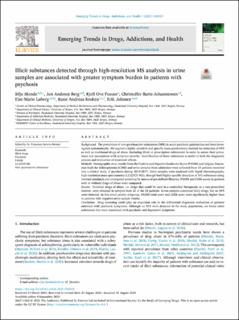| dc.contributor.author | Skrede, Silje | |
| dc.contributor.author | Berg, Jon Andsnes | |
| dc.contributor.author | Fossan, Kjell Ove | |
| dc.contributor.author | Bartz-Johannessen, Christoffer | |
| dc.contributor.author | Løberg, Else-Marie | |
| dc.contributor.author | Kroken, Rune Andreas | |
| dc.contributor.author | Johnsen, Erik | |
| dc.date.accessioned | 2022-03-25T14:00:06Z | |
| dc.date.available | 2022-03-25T14:00:06Z | |
| dc.date.created | 2022-01-30T11:51:25Z | |
| dc.date.issued | 2021 | |
| dc.identifier.issn | 2667-1182 | |
| dc.identifier.uri | https://hdl.handle.net/11250/2987708 | |
| dc.description.abstract | Background
The prevalence of new psychoactive substances (NPS) in acute psychotic patients has not been investigated systematically. We applied a highly sensitive and specific mass spectrometry method for detection of NPS as well as traditional drugs of abuse (including illicit or prescription substances) in order to assess their prevalence and associations with symptom severity. Identification of these substances is useful in both the diagnostic process and evaluation of treatment effects.
Methods
Demographic data, results from the Positive and Negative Syndrome Score (PANSS) and Calgary Depression Scale for Schizophrenia (CDSS) and urine samples from admission were collected from 53 patients recruited into a clinical study of psychosis during 2014-2017. Urine samples were analysed with liquid chromatography high resolution mass spectrometry (LC-QTOF-MS), through both highly specific detection of 191 substances using internal standards and untargeted screening by means of pre-defined libraries. PANSS and CDSS scores in patients with or without drugs of abuse were compared.
Results
Potential drugs of abuse, i.e. drugs that could be used in a controlled therapeutic or a non-prescribed manner, were detected in samples from 20 of the 53 patients. Seven samples contained illicit drugs, but no NPS were detected. In this small patient subgroup, PANSS total score and CDSS score were significantly higher than in patients with negative urine sample results.
Conclusion
Drug screening could play an important role in the differential diagnostic evaluation of patients admitted with psychotic symptoms. Although no NPS were detected in the study population, we found other substances that were associated with psychotic and depressive symptoms. | en_US |
| dc.language.iso | eng | en_US |
| dc.publisher | Elsevier | en_US |
| dc.rights | Navngivelse 4.0 Internasjonal | * |
| dc.rights.uri | http://creativecommons.org/licenses/by/4.0/deed.no | * |
| dc.title | Illicit substances detected through high-resolution MS analysis in urine samples are associated with greater symptom burden in patients with psychosis | en_US |
| dc.type | Journal article | en_US |
| dc.description.version | publishedVersion | en_US |
| dc.rights.holder | Copyright 2021 The Author(s) | en_US |
| dc.source.articlenumber | 100024 | en_US |
| cristin.ispublished | true | |
| cristin.fulltext | original | |
| dc.identifier.doi | 10.1016/j.etdah.2021.100024 | |
| dc.identifier.cristin | 1993492 | |
| dc.source.journal | Emerging Trends in Drugs, Addictions, and Health | en_US |
| dc.identifier.citation | Emerging Trends in Drugs, Addictions, and Health. 2021, 1, 100024 | en_US |
| dc.source.volume | 1 | en_US |

